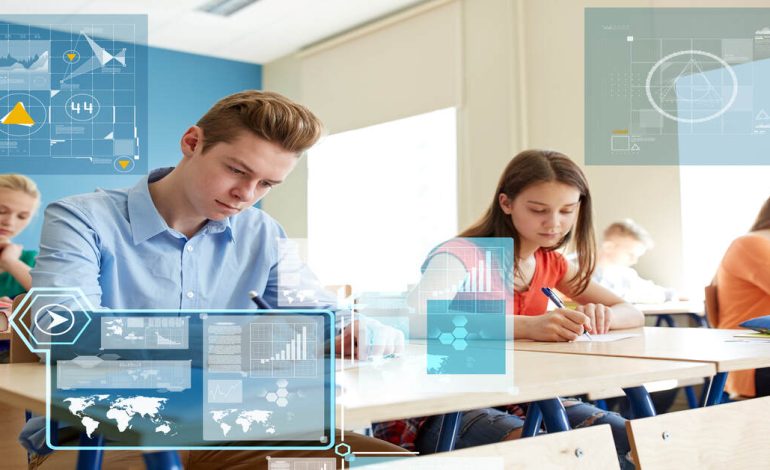How Is Technology Changing Education Through Innovation?

The use of technology in education has changed drastically in the past few years to the extent that it has altered how students learn and how the teachers teach. Since the emergence of digital tools and resources, the educational environment has changed away from the previous classroom environments to more discussion-based, and personalized learning environments. This blog will discuss the ways in which technology has promoted education, the new learning tools that are present in the market, and the effects that these new innovations have on the students and teachers.
How Technology is Developing in Education
Historical Context
Technology is not a new concept in education and it has developed over years. Since the invention of the overhead projector back in the 1960s through to the invention of the personal computers and the internet, every technological breakthrough has influenced the education practice. The development of the internet in the 1990s was a tremendous milestone and offered a variety of resources and information. Nowadays, due to the spread of smartphones, tablets, and cloud-based solutions, technology is now part of the learning process.
The Digital Divide
Although technology can be used to improve learning, it is important to note that there is digital divide among various socioeconomic classes. Technology access may be very different, and it may have an impact on the abilities of students to interact with digital learning tools. It is the duty of schools and policymakers to take care of these discrepancies in order to have equal opportunities to all students to enjoy the benefits of technological advancements.
The Implication of Technology in Education.
Technology in education manifests itself in many ways in the learning process, such as accessibility, engagement, personalization, and collaboration. Technology can have the following effects on education.
Accessibility
This has been enhanced by technology whereby education has become more accessible to the students, with varied needs. Assisted technology, including speech-to-text systems, screen readers, and adaptive learning systems, can be used to allow students with disabilities to engage in the learning process. Also, with the help of online courses and resources, learners in remote locations or with lower mobility will be able to receive quality education.
Engagement
It is important that the students are involved in the learning process. Technology offers interactive and multimedia contents that makes the students interested and improves their learning. Playing games, simulations, and virtual reality experiences enable the students to investigate ideas in immersive formats, which can make learning to be more enjoyable and efficient.
Personalization
All students learn at a unique pace and in their own manner. The use of technology makes it possible to have individualized learning. Adaptive learning systems are used to examine the performance of students and recalibrate the materials so that they can get the right challenges and assistance. The individualized treatment will enable the students to be more motivated and get higher performance.
Collaboration
Technology leads to a cooperation between the students and teachers eliminating geographical boundaries. Online discussion forums, collaborative documents and cloud based project management tools enable students to collaborate on projects, exchange ideas and learn among themselves. This group work environment encourages critical thinking and problem solving which are very important to succeed in contemporary employment.
Education Innovative Learning Tools.
Due to the ever-growing development of technology, many new learning tools have been created, which have changed the world of learning. The following are some of the most effective tools that are under use in the classrooms.
Learning Management Systems (LMS)
Learning Management Systems, including Moodle, Canvas, and Google Classroom, offer an instructor-centered hub through which they provide course content, task assignment, and student tracking. These systems simplify the process of communication among the teachers and students as it is easier to manage the assignments, share resources, and also give feedback. Moreover, LMS platforms tend to have such features as discussion boards, quizzes, and interactive modules to provide more engagement to the students.
Interactive Whiteboards
In most of the classrooms, interactive white-board which replaces the chalkboard provides a dynamic method of presenting information. The teachers are able to share the multimedia content, mark up the documents and involve learners in interactive classes. The boards offer team work, and students are able to approach the board and present their ideas, and even participate in discussions.
Educational Apps and Games
Mobile learning applications and games are trendy technologies that should be used to improve student learning. Applications such as Kahoot!, Quizlet and Duolingo are interactive and gamified to ensure that learning is enjoyable and fun. Such applications sometimes feature such options as customized learning paths, real-time feedback, and learning progress, enable students to study at their pace.
Virtual Reality (VR) and Augmented Reality (AR)
The technologies of Virtual Reality and Augmented Reality are transforming the sphere of education because they provide interactive learning. VR enables students to learn in virtual surroundings and undertake simulations that complement their learning of intricate ideas. As an example; students are able to have virtual field trip to historical places or learn about the human body in 3D. AR, in its turn, superimposes electronic content onto the physical environment, which can offer interactive learning experiences and incorporate physical and digital aspects.
Online Collaboration Tools
The use of online collaboration tools, including Google Workspace, Microsoft Teams, and Slack, can be used to allow students to collaboratively work on their projects in real-time despite their location. They are used in order to communicate, share files and manage projects, as well as cultivate teamwork and collaboration. The students are able to work collaboratively on documents, hold video calls and share resources without any inconvenience.
Artificial Intelligence (AI) In Education
Artificial Intelligence is finding its way into educational tools in order to improve learning. Student data can be analyzed by AI powered tools and used to offer tailored suggestions, dynamic learning paths, and customized interventions. To illustrate, chatbots could help students to answer more frequent questions, whereas AI-based analytics could aid an educator in recognizing disadvantaged learners and supporting them in due time.
Challenges and Considerations
Although the role of technology in education is largely favorable, a number of issues are bound to be overcome in order to make its application effective. These are some of the main factors to be taken into consideration
Teacher Education and Instruction.
Teachers should be properly trained and helped to incorporate technology in the teaching process. The professional development programs are supposed to be aimed at making the teachers realize the effective use of digital tools and how to include them in their lesson plans. The continuous support will be necessary to enhance the confidence and competence of the educators to use technology.
Screen Time and Well-being
With the growing involvement of technology in the education process, issues regarding the use of screens and its effect on the well-being of students have been brought up. A balance between traditional and digital approaches needs to be created. The teachers ought to conduct healthy screen time and advise students in taking up physical activities and real-life communication.
Data Privacy and Security
The privacy and security of data are the questions that are brought up by the use of technology in education. Schools and colleges should have strong policies and procedures to safeguard personal data of students as well as make certain that online platforms do not violate policies. The openness of information regarding the use of data and security strategies is essential in gaining trust among students and parents.
Equity in Access
One of the essential issues that should be considered in the use of technology in education is the digital divide. Schools should strive to provide students with access to the devices and the internet. Programs like device distribution to poor students and better internet connections in underserved communities are crucial to a fair access to technology.
The Future of Technology in Education
With the emerging and rising technology, education is even going to be more dynamic in the future. The following are trends and future projections of the role of technology in education:
Blended Learning Environments
The blended learning based on a combination of traditional face-to-face instruction with online learning is likely to be more common. This model makes it possible to have flexible learning experiences that can meet the needs of the individual and preserve the advantages of face-to-face interaction. The close connection between online and offline learning will be done smoothly as technology advances and this will result in improved education.
Data-Driven Decision Making
Data analytics in education will also allow the educators to make sound decisions based on the student performance and engagement. Through comparisons of data that have been acquired through different sources, schools will be able to detect trends, personalize interventions as well as enhance the entire educational strategy. Such a data-based method will make the teaching and learning more effective.
Gamification of Learning
The gamification of learning will keep growing because teachers will appreciate the motivation potential of the game-based features in learning. With the introduction of game mechanics, rewards, challenges and leaderboards, educators will be able to introduce more interactive and engaging learning experiences that are attractive to participants and lead to success among the students.
International Learning Opportunities
Technology will also enable easier access to learning opportunities worldwide with the ability to connect students and teachers worldwide. The use of virtual exchange programs, collaborative projects, and global classes will give the students the opportunity to experience cross-cultural or global citizenship and the feeling of understanding.
Lifelong Learning and Micro-Credentialing
The advancement of the technological world will pose a transition to lifelong learning due to the fast rate of technological change. The human being will have no option but to keep on developing their skills and knowledge as the industries grow. Micro-credentials and specialized courses will also be available online and will allow learners to obtain new skills on-demand and help them in their career growth and flexibility.
Conclusion
Technology is a revolution in the education sector that is changing how students study and how teachers teach. Technology has a multiplicity of benefits that can improve the results of education, whether it is increasing the accessibility and engagement to encouraging collaboration and personalization. New educational technologies and platforms are putting innovative learning tools and platforms in the hands of both educators and students, delivering interactive, dynamic and inclusive learning environments.
But with these developments that we are enjoying, there is need to deal with the issues surrounding technology in education. We can build a better future where technology supplements the education of all learners by means of offering sufficient training, ensuring fair access, and focusing on the privacy of data.
Going forward, it is important to note that technology is not a device that is meant to substitute conventional teaching, but rather it should be used to complement it. By balancing between online and in-person education, we can build an educational environment that will help students to adjust to the challenges and opportunities of the 21 st century. Technology holds great potential in determining the future of education and with the proper strategy it will have a major role in helping to make the next generation of learners.




